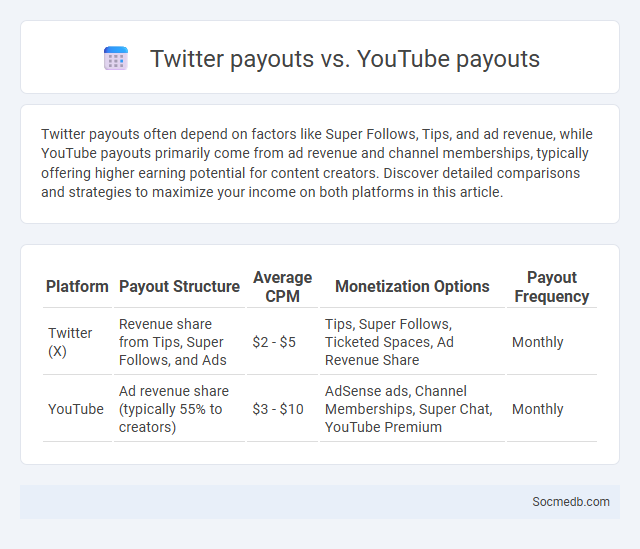
Photo illustration: Twitter payouts vs YouTube payouts
Twitter payouts often depend on factors like Super Follows, Tips, and ad revenue, while YouTube payouts primarily come from ad revenue and channel memberships, typically offering higher earning potential for content creators. Discover detailed comparisons and strategies to maximize your income on both platforms in this article.
Table of Comparison
| Platform | Payout Structure | Average CPM | Monetization Options | Payout Frequency |
|---|---|---|---|---|
| Twitter (X) | Revenue share from Tips, Super Follows, and Ads | $2 - $5 | Tips, Super Follows, Ticketed Spaces, Ad Revenue Share | Monthly |
| YouTube | Ad revenue share (typically 55% to creators) | $3 - $10 | AdSense ads, Channel Memberships, Super Chat, YouTube Premium | Monthly |
Overview of Twitter, YouTube, and Creator Monetization
Twitter serves as a real-time microblogging platform with over 400 million active users, enabling concise communication through tweets and trending topics. YouTube, the largest video-sharing site, hosts more than 2 billion logged-in monthly users and offers monetization options such as ad revenue, channel memberships, and Super Chat for creators. Creator monetization on both platforms emphasizes diversified income streams, including brand partnerships, sponsored content, and fan-based funding, enhancing revenue potential for digital content producers.
How Twitter Payouts Work for Creators
Twitter payouts for creators primarily occur through monetization features such as Super Follows, Ticketed Spaces, and Tip Jar, enabling users to earn revenue directly from their audience. Creators receive payments after Twitter deducts a standard platform fee, with funds transferred via supported payout methods like ACH or PayPal. Twitter's payout system leverages real-time analytics and audience engagement data to optimize creator earnings and ensure transparency in revenue distribution.
Understanding YouTube’s Monetization Structure
YouTube's monetization structure primarily revolves around the YouTube Partner Program (YPP), which enables content creators to earn revenue through ads, channel memberships, Super Chat, and YouTube Premium revenue. Eligibility requires a minimum of 1,000 subscribers and 4,000 watch hours in the past 12 months, ensuring active engagement on the platform. Revenue generation is influenced by factors such as viewer demographics, ad formats, and content niche, making targeted content optimization essential for maximizing earnings.
Key Differences Between Twitter and YouTube Payouts
Twitter payouts focus on monetization through tips, Super Follows, and ad revenue sharing, offering creators direct support from their audience. YouTube payouts primarily derive from ad revenue based on views and engagement within the YouTube Partner Program, which requires meeting specific eligibility criteria. Your earnings on Twitter can grow through real-time interactions, while YouTube's payout depends heavily on long-term content performance and subscriber growth.
Eligibility Criteria for Twitter and YouTube Monetization
To qualify for Twitter monetization, your account must have at least 10,000 followers and be active with consistent original content. YouTube requires 1,000 subscribers and 4,000 watch hours in the past 12 months to apply for its Partner Program. Ensuring your content complies with community guidelines is crucial for maintaining and maximizing Your revenue streams on both platforms.
Revenue Streams: Twitter vs YouTube
Twitter generates revenue primarily through advertising products like promoted tweets, accounts, and trends, supplemented by subscription services such as Twitter Blue. YouTube's revenue streams are more diversified, including ad placements via Google AdSense, YouTube Premium subscriptions, channel memberships, and merchandise shelf integrations. Your choice between platforms depends on whether you prioritize Twitter's real-time engagement or YouTube's extensive video monetization options.
Payout Frequency and Thresholds: Twitter vs YouTube
Twitter offers a payout frequency typically on a monthly basis, with a minimum payout threshold of $50 through its Tip Jar and Super Follows features. YouTube processes earnings monthly, distributing revenue once the creator reaches a $100 threshold in their AdSense account. Understanding these payout schedules and thresholds is crucial for creators optimizing their income streams across both platforms.
Creator Income Potential: Twitter vs YouTube
You can maximize your creator income potential by understanding the differences between Twitter and YouTube monetization models. YouTube offers diverse revenue streams including ad revenue, channel memberships, Super Chats, and brand partnerships, often generating higher consistent earnings for long-form content creators. Twitter monetization is evolving with features like Super Follows and Tip Jar, ideal for real-time engagement but currently delivers less scalable income compared to YouTube's proven, algorithm-driven content distribution.
Platform Algorithm Impact on Creator Earnings
Platform algorithms significantly influence creator earnings by determining content visibility and engagement rates, which directly affect monetization opportunities such as ad revenue, sponsorships, and fan support. Your content's placement in feeds and recommendation systems is often controlled by complex AI models that prioritize certain types of interaction, meaning that understanding and adapting to these algorithms can maximize your income potential. Creators who strategically align their content with algorithm preferences typically see higher reach and sustained revenue growth.
Future Trends in Social Media Monetization
Emerging artificial intelligence tools and augmented reality features are reshaping future trends in social media monetization by enabling creators to deliver personalized, immersive experiences that drive higher engagement and revenue. Platforms are increasingly integrating blockchain technology to facilitate transparent microtransactions and NFT marketplaces, empowering you to monetize digital content securely and creatively. Predictive analytics and data-driven ad targeting will optimize monetization strategies, ensuring maximum ROI for brands and influencers across evolving social networks.
 socmedb.com
socmedb.com